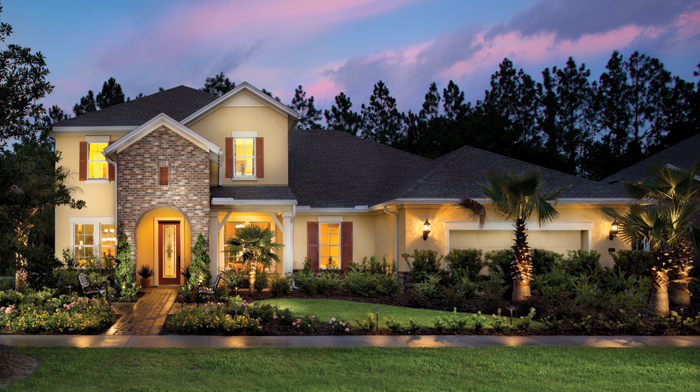
From $445,900 - The Windward by David Weekley Homes, 3,665 to 3,713 square feet, five bedrooms, four full bathrooms, one half-bathroom, three-car garage.
THE TIME IS NOW
If you've been waiting to buy a new home, here's why it's time to make your move.
So, you’re thinking of buying a new home? You’re not alone. Since the beginning of 2014, would-be buyers have visiting model centers, browsing the web and perusing home-related magazines at levels not seen since the boom days.
In Metro Orlando — considered to encompass Orange, Seminole, Osceola and Lake counties — the pace was frantic in the first quarter, sparking fears from some industry observers of a second “bubble.” Demand had pushed the average new-home price up by more than 20 percent over the past 18 months — a rate that was unsustainable.
As of this summer, the average price for a new home in the four-county area was $295,806. The average price for a resale home was about $165,000.
But the second quarter saw a marked cooling down, with the sale of all homes — both new homes and resales —increasing by only 1.8 percent compared with the same period a year earlier. Price increases are moderating as well.
Florida Realtors Chief Economist John Tuccillo describes the state’s real-estate market as “settling in.” And that’s good news for buyers, many of whom have stayed out of the fray lately because of uncertainty over which way the market is headed.
The answer, for now, seems to up — but more gradually. Look for steady, sustainable growth and reasonable appreciation in the months to come. In other words, no drama.
Investors buying and flipping homes for big profits are gone. That’s just as well, since their wheeling and dealing helped to artificially inflate prices during the boom. Likewise, there are far fewer short sales — down 52 percent in the second quarter of 2014 vs. the second quarter of 2013. That’s good, too, because short sales hurt home values in neighborhoods where they occur.
BUILDERS GET BUSY
Metrostudy’s second-quarter survey showed 2,374 single-family homes started in the four-county area. That’s down 2 percent from the same quarter last year. But the annual start rate, which encompasses the last four full quarters, hit 9,460. That’s up more than 18 percent year over year.
However, starts of new homes priced at $150,000 or less tumbled 28 percent year over year, reflecting increases in demand and costs to builders, such as land, labor, materials and governmental fees, according to the nationwide analytics firm, which tracks statistics for real-estate development and new-home construction.
Still, the number of single-family homes actually purchased, referred to as the closing rate, totaled 2,381 in the second quarter. That’s up more than 19 percent from the same quarter last year. The annual closing rate of 6,845 is up more than 28 percent year over year.
Anthony Crocco, regional director of Metrostudy’s Central Florida market, said buyers may experience a little “sticker shock” after several years of severely depressed prices. Nonetheless, he notes, interest rates remain near record lows and many builders are helping buyers through the use of incentives.
Total single-family home inventory, which is comprised of homes under construction, finished vacant homes and model homes, stood at 5,142 at the end of the second quarter, or seven months of supply. That’s an increase of about 15 percent over the same quarter last year. But move-in rates are accelerating, so Crocco notes that inventory isn’t out of kilter with demand.
Yes, prices are up from the bottom of the slump. But they’re still a bargain compared to prices at the height of the boom. Interest rates, although they’ve ticked up, are still near rock bottom. And best of all, mortgages are easier to get than you’ve been led to believe.
Speaking of mortgages, expect rates to rise through the end of the year as the Federal Reserve reduces its economic props through bond buying, according to Frank Northaft, chief economist at Freddie Mac.
“Regarding mortgage rates, we’ve gone from dirt cheap to cheap, and I think we will see a gradual rise of about a half a percentage point to 5 percent in 2014,” notes Nothaft. “But most markets will remain quite affordable.”
David Berson, chief economist at Nationwide Insurance, adds that there’s pent-up demand for homes because the nation has had abnormally low household formation in recent years.
For example, many recent college graduates returned home to live with their parents because the job market was tight or they found roommates to reduce costs. As the situation continues to improve, there’ll be growing demand for housing.
ORLANDO’S ADVANTAGES
It’s a particularly opportune time to buy in Metro Orlando, which sits at a solid No. 2 in the state on Metrostudy’s list of Top Markets by Outlook. Only The Villages, a massive retirement community that Metrostudy tracks separately, is expected to end 2014 with a greater percentage increase of new-home sales than Orlando’s four core counties.
Also powering the market is an improving employment situation. According to the University of North Florida, the market-wide unemployment rate was about 6.8 percent as of July, about three-quarters of a point lower than the national rate.
Metro Orlando, which really consists of many sub markets, reflects several somewhat contradictory national trends. More people are than ever are shopping infill developments closer to urban centers, such as Winter Park, College Park, Maitland and Downtown Orlando, all in Orange County.
At the same time, others are willing to swap short commutes for more square footage and cheaper prices. In fact, new-home sales Orange County alone were actually down about 3 percent in the second quarter of 2014 versus the same quarter last year. But sales were up about 55 percent in Lake and Osceola counties, both once considered to be far flung.
In Orange County, the average price of a new home was $350,000 as of June, according to Metrostudy. In Lake and Osceola counties, the average price of a new home was $240,000. “Projects in further-out locations may have some opportunities with the kind of pricing buyers need,” notes Crocco.
Horizon West to the southwest and Lake Nona to the southeast are Orange County’s major development bookends, and will drive the county’s growth for years, perhaps decades, to come.
In fact, residential construction in Lake Nona led the region in the second quarter with 415 sales. But Horizon West is just gearing up and should be posting equally impressive numbers soon.
According to Metrostudy, second to Lake Nona was ChampionsGate, a resort-style community in Osceola County, with 208 sales for the quarter. Other projects that had the strongest activity during the quarter were all in Orange County: Millenia Park, Eagle Creek, Summerlake, Windermere Trails and Wyndham Lakes Estates.
Lake County had one community, Heritage Hills, in Metrostudy’s Top 10. In addition to Champions Gate, Osceola County had a second community in the Top 10: Anthem Park. Seminole County, which has been largely built out for years, had no communities on the list.
AFFORDABILITY IS KEY
Nationwide, housing affordability dipped in the second quarter of 2014, according to the National Association of Home Builders/Wells Fargo Housing Opportunity Index (HOI), released in July.
Overall, 62.6 percent of new and existing homes sold between the beginning of April and the end of June were affordable to families earning the U.S. median income of $63,900. That’s down from the 65.5 percent of homes sold that were affordable to median-income earners in the first quarter. The national median home price increased from $195,000 in the first quarter to $214,000 in the second quarter.
How does Metro Orlando stack up? The index, which takes into account the price of both new and resale homes, places the four-county area somewhere in the middle, ranking it as the 141st most affordable market in the U.S.
According to the index, 68.2 percent of new and existing homes sold in Metro Orlando during the testing period were affordable to families earning the local median income of $54,800. The local median home price increased from $150,000 to $156,000 in the second quarter.
“The second quarter HOI reflects the slow, steady march toward the affordability levels we experienced before the mid-2000s boom,” says NAHB Chief Economist David Crowe. “While we’re seeing a slight decrease in affordability, it’s still fairly high by historical standards.”
HIGH-END BUYERS ARE BACK
Not all buyers worry about mortgage rates. The Orlando Sentinel recently reported that the buyer who snapped up former Orlando Magic star Dwight Howard’s estate in Seminole County paid $3.4 million in cash. And there were two other cash offers on the table.
Of the 20 Metro Orlando homes that sold for $2 million or more during the second quarter, 12 of them — 60 percent — sold for cash, according to RealtyTrac, a real-estate research firm. Nationally, 45 percent of buyers in that price range paid cash.
Whether they pay cash or not, high-end buyers are back. The Orlando Regional Realtor Association says that in the core Orlando market, which it defines as primarily Orange and Seminole counties, there were 156 sales of $1 million or more from January through July. That’s double the number five years ago.
In Metro Orlando, the high proportion of cash sales is being driven in large part by foreign buyers looking for a safe investment in a desirable location.
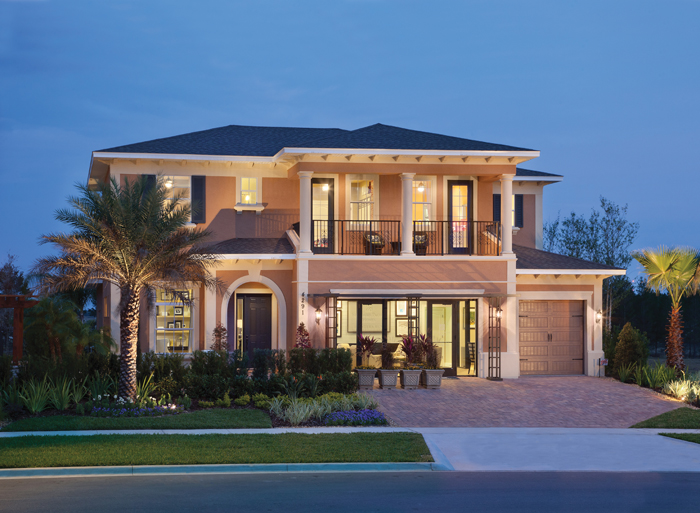
From $654,990 - The Bellingham by Standard Pacific Homes, 4,037 square feet, five bedrooms, three-and-a-half to five bathrooms.
IT’S NEW FOR YOU
Why settle for a fixer-upper when a state-of-the-art home doesn’t cost any more to own?
If you think fixer-uppers offer the best bang for your housing buck, think again. You can likely buy a new (or almost new) home with all the modern bells and whistles — and not spend any more per year.
Using data from the Census Bureau and Department of Housing and Urban Development’s 2011 American Housing Survey, NAHB found that a newer home — even a more expensive one — can cost the same or less per year to own and maintain than an older home with a lower up-front price tag.
NAHB’s study first looked at how utility, maintenance, property tax and insurance costs vary depending upon the age of the structure. It found that homes built before 1960 have average maintenance costs of $564 per year, while homes built after 2008 average $241 per year.
Similarly, operating costs average nearly 5 percent of the home’s value for pre-1960 structures, while they average less than 3 percent when the home was built later than 2008.
The study then compared the first-year, after-tax cost of owning newer and older homes, taking into account the purchase price, mortgage payments, annual operating costs and income-tax savings.
This data showed that a buyer can pay 23 percent more for a new home than for a home built before 1960 and still maintain the same first-year costs.
In other words, although mortgage payments may be slightly higher for a new home, operating costs will be lower, meaning the outlay is about the same for a higher-price new home than for a lesser-priced older home.
Other benefits of new homes include open floorplans, creative storage options and entertainment resources that cater to modern lifestyles. Plus, newer homes are far more energy efficient, with many built to certified green standards.
Of course, NAHB’s study compared more expensive newer homes with less expensive older ones. That isn’t always the case; in today’s market, depending upon the neighborhood, many comparable newer and older homes cost roughly the same at the outset.
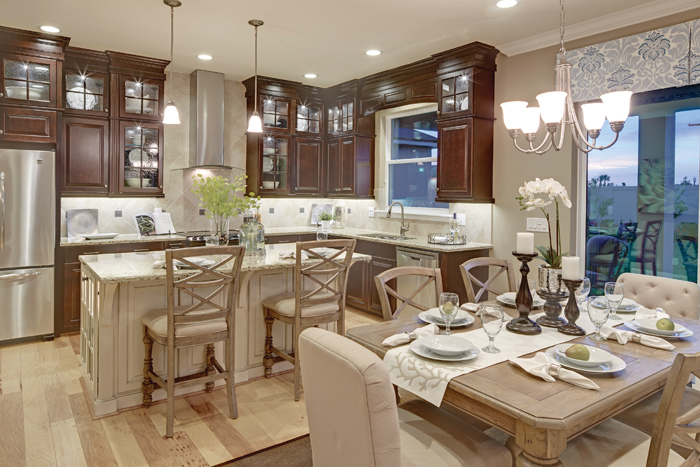
From $332,990 - The Winthrop by Mattamy Homes, 2,925 square feet, four bedrooms, two-and-a-half bathrooms.
MONEY MATTERS
Ready to take the plunge? Here’s a primer on what you need to do to get your fiscal house in order.
Everyone interested in becoming a homeowner should prepare early with orderly finances, solid information and plenty of patience for what could be a long and complicated process.
Since the housing market’s collapse in 2008, mortgage lenders have become more demanding in the documentation they require for financing a home sale.
That isn’t to say loans are impossible to get. They aren’t as easy to get as they used to be — which is probably a good thing — but if you have decent credit and know what to expect, you should be fine.
Here’s a primer on what potential first-time buyers need to do before they take the plunge:
• Order your credit report. You can request a free copy of your credit report from the three major credit bureaus — Equifax, Experian and Trans Union — via annualcreditreportcom. There are plenty of scams out there regarding credit reports, but you can use this link with confidence.
If you see accounts on your credit report that you don’t recognize, or if there are negative marks against you, act now to clear them up. Don’t be surprised to find bills you believe had been paid or balances with companies you’ve never even heard of.
Lenders like to see a low ratio of debt to credit, so it’s important to have more credit available than you use on a monthly basis. They also like to see long-standing lending relationships, so don’t close your oldest credit cards. However, if your balance on those cards is more than 30 percent of the allowable line, then pay it down.
Conversely, too many open lines of credit can impact your score negatively. The smartest move is probably to close recently acquired, low-limit credit cards that you no longer use and don’t really need.
And try not to buy anything — a car, for example — that requires anyone other than a mortgage lender to run a credit report. Multiple inquiries, even if you don’t ultimately borrow any money, can hurt your credit score.
• Create a monthly budget. In your calculations, set aside whatever you’ll be required to pay as a homeowner that you don’t now pay as a renter.
This includes the home mortgage, mortgage insurance, property taxes, condo or homeowner association fees, home furnishings, maintenance, cleaning and any utilities or fees that are currently your landlord’s responsibility.
Forcing yourself to live within this new budget month after month will vividly illustrate what you truly can afford. It will also help you pay down credit-card debt or put more money aside for a down payment.
Getting an idea of what your mortgage payment might be is relatively easy. Just enter the words “mortgage calculator” in your search engine and hundreds of websites will pop up. Pick one, find the simple form and enter the amount you anticipate financing.
You’ll also enter the term of the loan (likely 30 years) and the anticipated interest rate (the average 30-year, fixed-rate mortgage was 4.59 percent as of late August). The monthly payment based on those numbers will be calculated automatically.
Of course, that could all change — you may end up borrowing more or less, and you may not qualify for the most favorable mortgage rate. But it’s a good starting point.
If your goal is to keep your monthly payment less than $1,000, then you’ll have a general idea of the maximum amount you can borrow and still remain under that threshold.
A good rule of thumb is this: every 1 point interest-rate jump adds about $83 per $100,000 borrowed to your monthly payment. That likely wouldn’t be a deal breaker for most people, so you shouldn’t allow the rush to avoid a modest rate increase force you into home you’re not entirely happy with.
It’s also helpful to consider some historical context, especially if you’re a first-time buyer and haven’t been in the market before. Mortgage interest rates in the 4 percent range were unheard of until 2010, and rates in the 5 percent range were unknown prior to 2003.
In the early 1970s, rates hovered in the 7 percent range and spiked up above 9 percent in late 1975, late 1976 and most of 1978. At the end of the decade and throughout the 1980s, rates rarely dipped lower than 10 percent, and even hit 18 and 19 percent for a brief time.
So, yes, rates have gone up lately — but they’re still near historic lows.
Also, start keeping your financial statements and pay stubs in a file, where you’ll put new documents as they arrive so that everything remains current. Mortgage lenders will eventually be asking for much of this material.
Any lender will need to see documentation of your income, employment, at least two years of IRS filings and records of your 401(K) fund and other assets.
If you’re buying a new home instead of a resale, you’ll need to take the same preparatory steps. But many new-home builders, especially larger national companies, may offer their own attractive financing packages, either directly through a mortgage subsidiary or via an affiliated lender.
• Consult a psychic. Okay, that one was facetious. Nobody can predict the future. But the smart money says that you should buy a home only if you’re reasonably sure you’ll be staying put for at least five years
Consider your personal and professional plans and try to determine whether there’s any chance you might move to another city for work or add to your household through marriage or childbirth, both of which have implications for your income as well as the size and location of the home best suited for you.
• Find a qualified agent. Most new-home builders have internal sales departments and highly qualified people manning their models and sales centers.
But independent real-estate agents also work in the new-home market, and can be especially helpful if you’re from out of the area and need someone who knows the lay of the land.
A good real-estate agent can advise you on new-home communities as well as individual listings in established neighborhoods. He or she can also negotiate the price, walk you through the financing process and serve as an objective voice when emotion threatens to overtake reason.
• Investigate potential lenders. Whether you work with a specific lender or a mortgage broker who can connect you with many different lenders, it’s important to shop around.
You don’t want to let a quarter-point-lower rate tempt you into using an Internet-based lender, and then be unable to reach the underwriter when you’re in the middle of a fast-moving bidding war.
And yes, bidding wars are back — at least in some neighborhoods.
Your lender can sort through your financing options and explain the pros and cons of each. You’ll also get a realistic view of how much you can borrow, based on your income and credit.
Ask your lender to run a hypothetical scenario so that you have a written estimate of the monthly principal and interest payments, closing costs, insurance fees and property taxes.
In addition, your lender can analyze your credit report and offer suggestions on boosting your score. He or she will also know how long it might take for clean-up actions to be reflected in the credit bureaus’ records.
Finally, armed with all this information and confident that you know what you’ll be able to spend, start looking for a home you love.
After all the tedium leading up to the actual search, you’ll enjoy strolling through model centers confident that you can make your homeownership dreams come true.
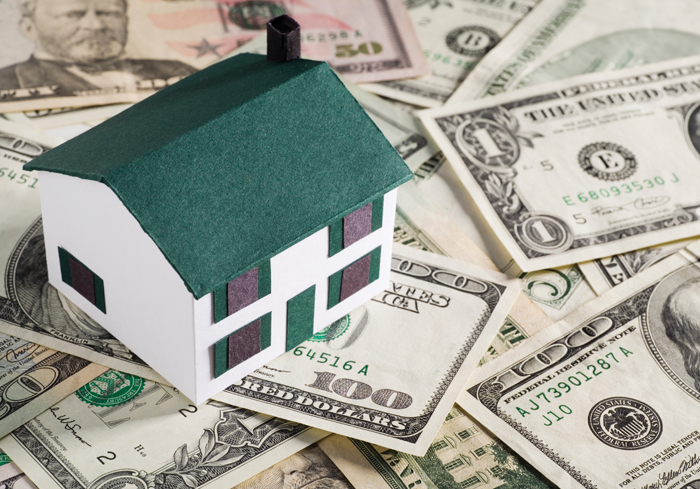
A HELPING HAND
Down payment gifts are a great way to improve your mortgage borrowing power.
There’s certainly no shame in getting help from a family member — or anybody else in a position to offer assistance — when you’re gathering money for the down payment on a home.
The tight U.S. economy, plus a proliferation of first-time buyers, has increased the number of mortgage applicants using cash gifts from family and friends. It’s not at all uncommon.
Plus, there are many good reasons to make a healthy down payment. If you put as much as 20 percent down, you’ll be more likely to get the most favorable interest rate available and there’ll be no private mortgage insurance (PMI) charge.
That all adds up to significant savings over time. So, if you have someone who’s willing to help, then by all means take the money.
It’s important, however, that you “accept your gift” properly. Do it improperly and your lender is likely to reject your loan in underwriting.
If you don’t want to make a 20 percent down payment, that’s fine. You can use gift money for other loan programs, including the FHA purchase mortgage, which requires a 3.5 percent down payment, and the Fannie Mae Conventional 97 program, which requires just 3 percent down. In any case, there’s a process to be followed when accepting a cash down payment gift, and the rules must be followed to the letter.
First, the gifter should write a gift letter that includes the following information:
• The amount of the gift;
• The subject property address;
• The relationship of the gifter to the giftee;
• A note that the gift is actually a gift and not a loan.
If you’re the gifter, then write a check to the giftee for the exact dollar amount specified in the letter. Photocopy the check, keep one copy for your records and give one copy to the giftee. (If you’ve sold stock to raise the cash, make sure that you document the sale as well as the transfer of funds from your brokerage account into the account from which you’re making the gift).
Yes, writing a check seems a bit old-school when you could simply transfer the funds electronically. But by creating a paper trail, you’ve made it easier for the lender to verify the transaction.
After receiving the check, the giftee should deposit it in person. Again, entering a bank and speaking to a teller seems quaint these days, when so much banking is done online. But this is one transaction you’ll really want to handle yourself.
Remember: Don’t co-mingle the gift deposit with other funds. The amount specified on your receipt should match exactly the dollar amount on the down payment gift letter. If it’s off by even a penny, the lender may reject your letter and the funds that came with it.
If you’re receiving multiple gifts — we should all be so lucky —then follow this same process for each one independently. Separate deposits, matching receipts. You know the drill by now.
Oh, and speaking of letters, an old-school “thank-you” letter to whoever ponied up isn’t a bad idea, either.

THE LOAN RANGER
There are an array of mortgage options. Here’s how to pick the one best for you.
Despite what you may have read about how difficult it is to get a mortgage loan, the fact is that 60 percent of people who apply are eventually approved.
Lenders have simply gone back to basics, requiring steady employment, a low debt-to-income ratio and a good credit score. For example, your proposed monthly housing expense, including payments for taxes and insurance, shouldn’t exceed about 28 percent of your gross monthly income.
If you don’t know what your taxes and insurance will be, figure them at roughly 15 percent of your estimated mortgage payment.
Your proposed monthly housing expense, plus other recurring payments, such as car loans, child support and alimony, credit cards and student loans, shouldn’t exceed about 36 percent of your gross monthly income.
Depending on your specific situation, there may be some flexibility in the 28 percent and 36 percent guidelines, which are sometimes referred to as “front-end ratios” and “back-end ratios.”If you’re able to buy a home while borrowing less than 80 percent of its value by making a large cash down payment, the qualifying ratios become less critical.
In general, however, if the ratios are right, and if you have a credit score of more than 620, you should be able get a home loan.
But there’s no question that today’s borrowers have fewer options than they did prior to 2008, when a steady pulse was just about all you had to demonstrate.
To find out more about the different sources that provide home financing, and the features and benefits of the various loan products they offer, check with your banker or mortgage lender. In the meantime, here’s a summary:
• FHA Loans. If you’ve got only minimal cash for a down payment and your credit history has a few blemishes, a federal government-backed loan is most likely your best choice. Federal Housing Administration (FHA) loans allow down payments as low as 3.5 percent along with generous credit underwriting.
• VA Loans. Veterans Administration (VA) loans require no down payment, but you must be a veteran to qualify. United States Department of Agriculture (USDA) rural loans also allow zero down, but they’re limited to areas with relatively small populations and may have income restrictions.
• Conventional Loans. If you have more than 10 or 20 percent to put down, these may be your best bet. Conventional loans are designed to be sold to Fannie Mae and Freddie Mac, the government-chartered mega-investors. The downside is, conventional underwriting rules are more strict now, and banks may impose add-on fees to loans, thereby increasing your cost. Down payments below 10 percent may be allowed, but they’ll require high private mortgage insurance premiums.
• Construction Loans. A construction loan is useful if you’re building a home yourself as general contractor or working with a custom builder. Most construction loans provide short-term funds designed to get you through the building stage of your project (six to 12 months) followed by a conversion into a permanent long-term loan of 30 or 15 years.
• Builder Financing. Most large- and medium-sized builders either have wholly owned mortgage subsidiaries or affiliate relationships with outside mortgage companies. Some builders also offer title insurance and settlement services. If the builder handles your financing, your loan may be included in a package that encompasses sales incentives such as upgrades and price breaks. Financing through your builder may also reduce the time needed to move from application through settlement.
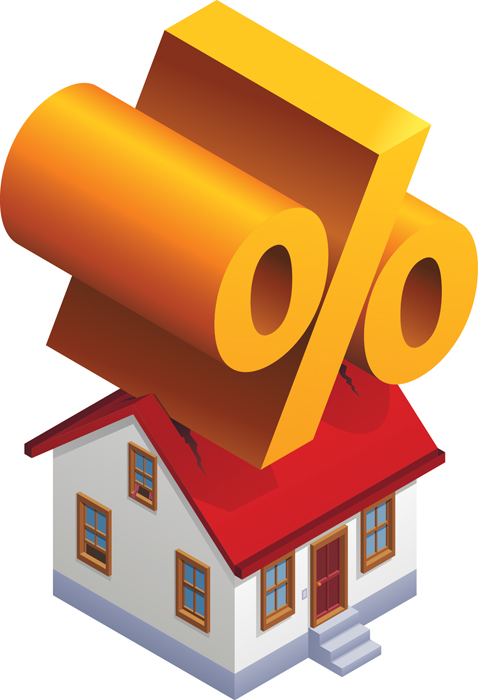
MAKE A BREAK
Tax incentives aren’t just for millionaires. Here’s one that’s just for first-time buyers.
The Florida Housing Mortgage Credit Certificate (MCC) Program can help first-time homebuyers save money each year that they live in their home.
Through the MCC Program, administered by the Florida Housing Finance Corporation (FHFC), you can claim up to 50 percent of your paid mortgage interest each year as a tax credit on your federal tax return.
A tax credit actually lowers your tax bill dollar for dollar, while a tax deduction reduces your taxable income. For example, if you’re in the 25 percent tax bracket, a $1,000 deduction lowers your tax bill by $250. But a $1,000 credit lowers the bill by the full $1,000, no matter which bracket you’re in.
The MCC credit is capped at $2,000 annually. Any amount above that is still eligible for the standard home mortgage interest deduction.
Florida’s MCC Program is designed for first-time homebuyers purchasing a home, non-first-time homebuyers purchasing a home in targeted areas or eligible veterans purchasing a home anywhere in the state. The MCC Program has income and purchase price requirements that differ from county to county and vary according to household size.
In the Central Florida counties of Orange, Seminole, Osceola and Lake, the purchase price limit is $268,875. The income limit is $70,220 for a household of one or two people.
To participate, you must meet the qualifying requirements for a mortgage loan and use the home as your primary residence. A first-time buyer is consider to be a person who has never owned a home, or has not owned a home in the past three years.
The credit helps in another way: Your mortgage lender will deduct the amount of the credit from your estimated payment when calculating your debt-to-income ratios. This can help you qualify for a larger loan than you otherwise could.
Best of all, the credit lasts for as long as you own the home and it remains your principal residence, although you could be required to repay some of the subsidies if you sell your home before nine years.
FHFC has been authorized to grant up to $125 million in tax credits, which sounds like a lot. But with so many first-time buyers entering the market, it’s possible for the program to max out. So if you’re interested, you should start the application process right away.
For more information, visit floridahousing.org.
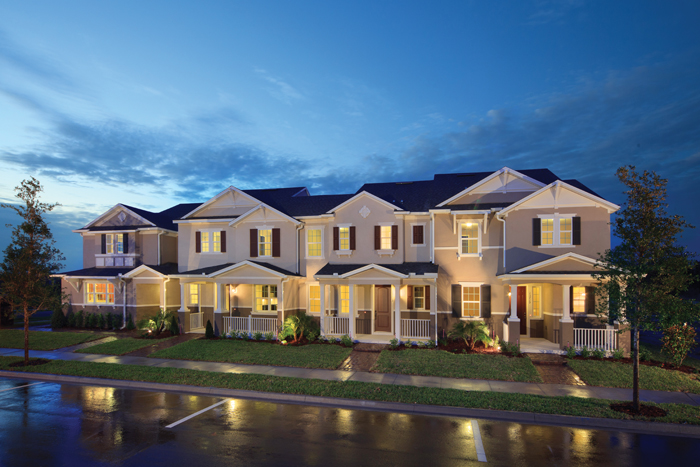
From $225,990 - Lifestyles at Vineyard Square Townhomes by KB Home, from 1,913 to 2,119 square feet, two to four bedrooms, two-and-a-half bathrooms and a two-car garage.
